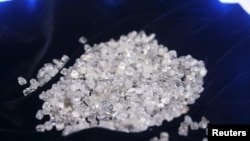Diamond industry experts are hailing the signing of a 10-year diamond sales agreement between the De Beers Group and Botswana, Africa's largest diamond producer. Under the deal, Botswana will progress from receiving 30% to half of all diamonds that De Beers mines in the southern African country.
The deal was signed at the 11th hour following tense negotiations, as Botswana pushed for an increased allocation of rough diamonds from the 54-year-old partnership.
The signing of a new agreement on Saturday has been welcomed by industry experts.
Edward Asscher, the World Diamond Council immediate past president, told VOA the deal will ease anxiety within the diamond industry.
“First of all, that is a guarantee of stable supply of rough diamonds and we have all been waiting for this. Don’t forget that De Beers is the leader in the rough diamond industry, but it also provides stability in the market and it’s the only company in the diamond industry that is investing in the growth and marketing of natural polished diamonds,” said Asscher.
Belgium-based researcher on diamond mining Hans Merket said the new deal gives Botswana a greater chance to enjoy the proceeds of diamond mining.
“The current deal builds on the achievements of the past to now expand Botswana’s own room of maneuver in generating lasting benefits from the exploitation of its natural resources. The potential is definitely there but it remains to be seen how all this plays out,” Merket said.
He, however said while there is need for transparency from the two parties on the deal, a concern recently raised by some legislators in Botswana’s National Assembly.
“What has been released so far (about the deal), there are many unknowns and conditionality. The past few years have shown that ill-informed public debates can breed mistrust between the two parties, or between the company and public at large. So, it will be important to invest in transparency and awareness raising to avoid this. The ideal way to achieve this will be to join the Extractive Industry Transparency Initiative.”
The Extractive Industry Transparency Initiative is a global standard aimed at ensuring the good governance of oil and mineral resources.
Meanwhile, De Beers chief executive Al Cook, speaking during the signing of the agreement in Gaborone Saturday, said the company is excited to continue its partnership with Botswana.
“We at De Beers will never forget that it is a privilege to be the partners of the government of this great country. It is a privilege, it is not a right. We will always remember that it is a privilege.”
In recent years, Botswana has received about $5 billion per year from De Beers.
During negotiations, Botswana President Mokgweetsi Masisi repeatedly indicated his country was prepared to walk away from negotiations if a more favorable deal were not reached.
Minerals Minister Lefhoko Moagi said the new deal represents the aspirations of the people of Botswana.
“I am very happy today that we are here and it is all to do with people. Everything else comes second. It is about our people and it will continue to be about our people. We will continue to do that for the betterment of the people of Botswana and all our partners,” Moagi said.
Botswana sells its allocation of the rough stones from De Beers through state entity, the Okavango Diamond Company.
The two parties also agreed to extend the mining licenses by 25 years. The licenses will now run until 2054.









